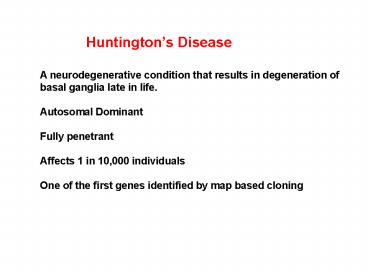Huntingtons Disease - PowerPoint PPT Presentation
1 / 26
Title:
Huntingtons Disease
Description:
100's of DNA markers mapped onto each chromosome. high density linkage map. ... Mapped gene to end of chromosome 4 using RFLPs and other polymorphic. DNA ... – PowerPoint PPT presentation
Number of Views:99
Avg rating:3.0/5.0
Title: Huntingtons Disease
1
Huntingtons Disease
A neurodegenerative condition that results in
degeneration of basal ganglia late in life.
Autosomal Dominant Fully penetrant Affects 1
in 10,000 individuals One of the first genes
identified by map based cloning
2
Gusella et al 1984. Science 225, 1320-1326
3
100s of DNA markers mapped onto each chromosome
high density linkage map. the relative
location of 100s of polymorphic DNA markers on
chromosomes can be mapped using mapping panels.
First step. Find approximate chromosomal
location of gene using few large families or
many small families. Use LOD score to determine
if markers are linked to gene in human families.
The LOD score allows you to compare families in
which marker and gene are either in repulsion or
in coupling.
4
Gusella et al 1984. Science 225, 1320-1326
5
DNA was collected from family members Many
sequences known to be polymorphic in humans were
tested to find sequences that are linked to
disease. i.e. find polymorphic alleles that
cosegregate with disease allele. RFLPs were
tested. Restriction Fragment Length
Polymorphisms One locus with a HindIII
polymorphism was linked in two large families
tested.
6
HindIII polymorphism is closely linked to disease
Marker G8 from a randomly chosen phage clone with
a 17.6 kb human DNA insert.
7
Allele C is always found in affected individuals
with one exception
Marker G8 is linked to Huntingtons disease at a
distance of 2 cM With a LOD score of 12.1
Some unaffected individuals also have allele
C but in these cases it could be from an
unaffected parent
8
The Huntington research group identified the
gene that distinguishes healthy from diseased
family members. Cell 1993.
Mapped gene to end of chromosome 4 using RFLPs
and other polymorphic DNA markers in 75
families. Cloned end of chromosome 4 into a
yeast artificial chromosome. Subcloned into
cosmid vectors (phage based- 40 kb
inserts). Identified contig - overlapping
clones that represent the linear order of DNA on
the chromosome. Defined minimal region to 500 kb
between two polymorphic DNA markers. Identify
transcribed sequences in that minimal region.
9
Physical map of region that contains Huntingtons
gene
Huntington Disease Collaborative Research Group
1993 75 families from all over the world tested
for closer markers 500 kb region between D4S180
and D4S182 no recombinations
10
Fig. 10.7
Sequences of with overlap are assembled into
contigs Contigs are contiguous
sequences. Contigs from overlapping clones can
be assembled to recreate the full chromosome.
11
Fig. 10.8
12
Fig. 10.10
13
Fig. 10.11
14
Physical map of region that contains Huntingtons
gene
Huntington Disease Collaborative Research Group
1993 75 families from all over the world tested
for closer markers 500 kb region between D4S180
and D4S182 no recombinations
15
Once a small interval has been defined, how to
find the correct gene?
List of genes predicted from sequence. Examine
mRNA expression patterns to focus on genes
expressed in tissues affected by
disease. Compare alleles of candidate genes
between healthy and affected individuals.
16
Exon trap used to identify expressed genes in
Huntingtons interval
Bucker et al. 1991 PNAS 88, 4005-4009
17
(No Transcript)
18
(No Transcript)
19
Screened sequences from clones representing
contig, 4 transcripts found.
20
IT15 encoded a gene that had a DNA
sequence difference between healthy and affected
family members. Expressed in many tissues
including brain
21
Structure of Huntingtin protein
Polyglutamine repeats (CAG codon) are expanded
in diseased individuals
Sawa 2001 J. Mol. Med. 79, 375-381.
22
Once the gene is available, new studies can be
initiated to understand disease
Mouse model transgenic mouse with expanded
polyglutamine repeats. Heterozygote has
neurodegenerative disease similar to
Huntingtons. Develop abnormal deposits of
huntingtin fragments in inclusion bodies of
neurons. Express huntingtin protein in cultured
nerve cells Mutant fragments accumulate in
clumps and cells die Normal protein also
fragmented but clumps do not develop. May be
clumps are toxic or Maybe fragments with longer
polyglutamine repeats are toxic.
23
Possible toxic effects of huntingtin leading to
nerve cell death
Huntingtin binds some transcription factors.
Mutant Htt also binds May take transcription
factors out of action. Mutant but not normal
Htt binds p53 transcription factor, p53 is a
regulator of cell death As a result,Ca2 flow
altered in mitochondria, Cell death. Mutant also
binds a histone deacetlyase. Modification of
gene expression.
24
Normal Huntingtin may protect nerve cells from
death by performing essential
functions. Normal Htt is part of a complex that
transports a hormone, Brain derived
neurotrophic factor along axons of medium spiny
neurons. These are first to degenerate in
Huntingtons Disease. Mutant Htt cannot perform
transport function. But HD is dominant . It
may be toxic or heterozygotes may have
insufficient functional protein for normal
development. Haploinsufficient.
25
Possible functions of Huntingtin leading to
disease
26
Although the function of Huntingtin is still not
known, treatments are being tested to reduce the
symptoms
Caspase blockers
Anti-apoptosis































